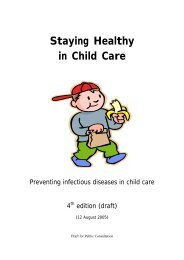Clinical Practice Guidelines - National Health and Medical Research ...
Clinical Practice Guidelines - National Health and Medical Research ...
Clinical Practice Guidelines - National Health and Medical Research ...
Create successful ePaper yourself
Turn your PDF publications into a flip-book with our unique Google optimized e-Paper software.
At-risk individuals include:<br />
• all first degree relatives, <strong>and</strong> depending on information available on disease status of intermediate<br />
relatives, sometimes more distant relatives of affected individuals, until the family APC mutation<br />
has been identified<br />
•<br />
once the family APC mutation has been identified, relatives who have been found to carry the<br />
family specific mutation,<br />
as well as untested close relatives.<br />
The recommended protocol for screening is:<br />
flexible sigmoidoscopy annually or biennially from age 12–15 years to 30–35 years until polyposis<br />
develops. Depending on likely compliance, sigmoidoscopy<br />
is often done yearly to establish better<br />
rapport with the individual <strong>and</strong> continuity of care. Cancers are exceedingly rare in teenage years,<br />
guiding the timing of surgery usually to later teenage years. if no family specific mutation has been<br />
identified, <strong>and</strong> no adenomas have developed, sigmoidoscopy as above until 35 years, <strong>and</strong> then every<br />
three years after the age of 35 years, in view of the diminishing likelihood that the person has<br />
inherited the APC mutation. Population-based recommendations can then be introduced from 55<br />
years. 21<br />
• colonoscopic screening is appropriate for families with attenuated FAP, as recto-sigmoid sparing<br />
can occur<br />
in this variant of the disease.<br />
• Dye spray scattering (chromo-endoscopy) at flexible sigmoidoscopy or colonoscopy increases<br />
detection of polyps <strong>and</strong> enhances information<br />
about the phenotype. This may facilitate decision<br />
making about which genes to interrogate in the process of a germline mutation search. Dye spray<br />
scattering should be considered in investigations to make the initial diagnosis.<br />
Aus tralian experience indicates that the causative APC gene mutation can be identified in over 85% of<br />
,22<br />
FAP families .The APC gene is a large gene, spanning 15 exons on chromosome 5. Mutations in<br />
different families are scattered throughout the gene. Most mutations produce a premature stop codon<br />
o<br />
18<br />
resulting in an abnormally shortened protein product. Such proteins can be readily identified in the<br />
laboratory using the protein truncation test. 23,24 Other mutational analytic strategies may be required t<br />
optimise the detection rate (e.g. deletion studies). The exact description of the causative mutation is<br />
found by sequencing.<br />
Once a causative APC mutation has been identified for the family, genetic testing may be used to<br />
distinguish mutation-positive<br />
<strong>and</strong> mutation-negative family members. Such predictive testing cannot<br />
proceed in at-risk members until the specific mutation has been identified in at least one affected<br />
family member.<br />
uld<br />
25 Individuals shown not to carry the family-specific mutation no longer require<br />
intensive screening, with their risk reverting to that of the general population. Since the mutation (<strong>and</strong><br />
disease) cannot skip generations, there is no need to test the children of such individuals. When a<br />
causative gene mutation is identified, at-risk children are generally offered testing when they wo<br />
otherwise be commencing flexible sigmoidoscopy (e.g. in early to mid teens). Those testing positively<br />
will require annual sigmoidoscopy. It is important to check the histological features of a<br />
representative sample of any polyps found, because lymphoid polyps are sometimes large <strong>and</strong><br />
numerous in children <strong>and</strong> can be mistaken for adenomas. It is usual to plan surgery once there is an<br />
endoscopic diagnosis with pathological confirmation. 14<br />
Appropriate surgical options for prophylactic management in FAP include total colectomy <strong>and</strong><br />
21,26<br />
ileorectal anastomosis, or restorative proctocolectomy with<br />
pouch formation. The usual age for<br />
these procedures is in the later teenage years, or early adulthood at the latest. Lifetime follow up of<br />
the rectum every 6 to 12 months after ileorectal anastomosis, or a pouch (after restorative<br />
proctocolectomy), is required; development of cancer, severely dysplastic adenomas or<br />
High-risk familial colorectal cancer syndromes 71

















